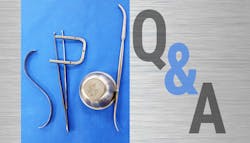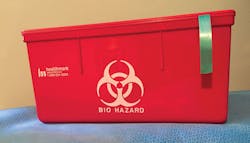Precleaning instruments; proper use of container signage
Submit your questions: email: [email protected]
CS Solutions
Q Currently we handwash all instruments that come from the operating room (OR) prior to running them through the washer decontaminator. Unused instruments, which the OR sends back to decontamination, are visually inspected and if any soil is found then the instruments are manually washed and then put in the washer. If no visual soil is found, then the unused instruments go directly into the washer. Does this practice meet the current standards for cleaning instruments?
A Let me start by reaffirming that the manufacturer’s instructions for use (IFU) for cleaning each specific instrument or other medical device is to be consulted and followed. Some may specify that manual precleaning be done before placing instruments into the automated washer, but you’ll likely find that most do not require this.
As a rule, for personnel safety, we should strive to minimize the excessive handling of contaminated items. Guidelines and standards do state that gross soil should be removed from surgical instruments at the point-of-use and that soiled instruments should be maintained in a moistened state in transit and prior to the start of the decontamination/cleaning process. If excessive or dried-on organic matter is observed on instruments. which may present too great of a challenge to the washer, then some additional manual precleaning or treatment may be necessary.
Q I am the clinical director of infection control and prevention at a large medical center. We have centralized all reprocessing and sterilization functions to our central processing department (CPD). We have over 50 patient-care units, clinics and offices that now send all their soiled instruments back to CPD for reprocessing. We have established a very strict protocol for the safe transporting of soiled instruments from patient or procedure rooms to soil utility rooms located at each unit where they are held until picked up by or returned to CPD.
We have invested in all new special containment devices for holding and transporting contaminated materials. These containers comply with all OSHA requirements including the appropriate biohazardous labeling. Instruments from a procedure or treatment room are placed in a small transport container and carried to the utility room and transferred into a larger container where they are held until the larger container of soiled items are returned to CPD. The smaller containers are cleaned and identified as clean with a green band; they are then placed on a supply cart in the clean utility room.
Recently a manufacturer’s representative was conducting an in-service and noticed the soiled bins with biohazard symbols stored amongst clean and sterile supplies. He stated that TJC would have an issue with that practice and suggested I consider an alternative. I really don’t see why they would have an issue as the bins do have the green band on them, which staff understands means the bins are clean (see figure 1). We also store our red biohazard plastic bags in that area, and I have never had an issue with TJC in the past. Do you see an issue with this?
A I do believe that your current method of identifying the container as clean could very well result in a negative response and citation from a surveyor. Signage needs to be clearly understood and precise. Having both a biohazard and “clean” marker present is contradicting and confusing and could leave the viewer to guess whether it is biohazard or clean. Further, having biohazard material in a clean and/or sterile storage space would be a breach in technique.
I agree that you should consider a more appropriate alternative. An easy fix would be to attach a specially designed CLEAN stick-on label over the biohazard symbol on the container (see figure 2). The label, while adhesive, can easily be removed when the container is in use holding contaminated items. Once the label is removed no adhesive residual remains on the container.
About the Author

Ray Taurasi
Ray Taurasi is Principal, Healthcare CS Solutions. His healthcare career spans over five decades as an Administrator, Educator, Technologist and Consultant. He is a member of AORN, SGNA, AAMI and a past president of IAHCSMM. Taurasi has been a faculty member of numerous colleges teaching in the divisions of business administration, nursing, and health sciences. He is the author of numerous articles and textbook chapters; he is a frequent speaker at national and international healthcare conferences.
Note to readers from Ray Taurasi - In 2021, my life’s career path will transition to one of new opportunities and adventures. As a result, after nearly 19 years and 225 CS Solution columns, this edition will be my last.
“All changes, even the most longed for, have their melancholy; for what we leave behind us is a part of ourselves; we must die to one life before we can enter another.”– Anatole France
I wish you and your loved ones a healthy and joyful holiday season and a beautiful New Year! God Speed, Ray
https://www.facebook.com/pages/category/ Local-Business/Healthcare-CS-Solutions-128857 3061153887/ • email: [email protected]


